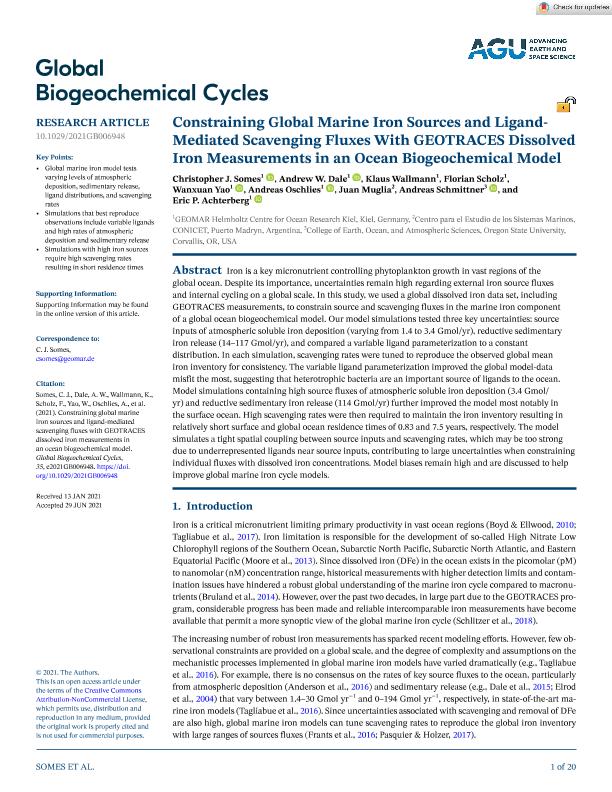Mostrar el registro sencillo del ítem
dc.contributor.author
Somes, Christopher J.
dc.contributor.author
Dale, Andrew W.
dc.contributor.author
Wallmann, Klaus
dc.contributor.author
Scholz, Florian
dc.contributor.author
Yao, Wanxuan
dc.contributor.author
Oschlies, Andreas
dc.contributor.author
Muglia, Juan

dc.contributor.author
Schmittner, Andreas
dc.contributor.author
Achterberg, Eric P.
dc.date.available
2022-07-29T13:14:25Z
dc.date.issued
2021-08
dc.identifier.citation
Somes, Christopher J.; Dale, Andrew W.; Wallmann, Klaus; Scholz, Florian; Yao, Wanxuan; et al.; Constraining Global Marine Iron Sources and Ligand‐Mediated Scavenging Fluxes With GEOTRACES Dissolved Iron Measurements in an Ocean Biogeochemical Model; American Geophysical Union; Global Biogeochemical Cycles; 35; 8; 8-2021; 1-20
dc.identifier.issn
0886-6236
dc.identifier.uri
http://hdl.handle.net/11336/163493
dc.description.abstract
Iron is a key micronutrient controlling phytoplankton growth in vast regions of the global ocean. Despite its importance, uncertainties remain high regarding external iron source fluxes and internal cycling on a global scale. In this study, we used a global dissolved iron data set, including GEOTRACES measurements, to constrain source and scavenging fluxes in the marine iron component of a global ocean biogeochemical model. Our model simulations tested three key uncertainties: source inputs of atmospheric soluble iron deposition (varying from 1.4 to 3.4 Gmol/yr), reductive sedimentary iron release (14–117 Gmol/yr), and compared a variable ligand parameterization to a constant distribution. In each simulation, scavenging rates were tuned to reproduce the observed global mean iron inventory for consistency. The variable ligand parameterization improved the global model-data misfit the most, suggesting that heterotrophic bacteria are an important source of ligands to the ocean. Model simulations containing high source fluxes of atmospheric soluble iron deposition (3.4 Gmol/ yr) and reductive sedimentary iron release (114 Gmol/yr) further improved the model most notably in the surface ocean. High scavenging rates were then required to maintain the iron inventory resulting in relatively short surface and global ocean residence times of 0.83 and 7.5 years, respectively. The model simulates a tight spatial coupling between source inputs and scavenging rates, which may be too strong due to underrepresented ligands near source inputs, contributing to large uncertainties when constraining individual fluxes with dissolved iron concentrations. Model biases remain high and are discussed to help improve global marine iron cycle models.
dc.format
application/pdf
dc.language.iso
eng
dc.publisher
American Geophysical Union

dc.rights
info:eu-repo/semantics/openAccess
dc.rights.uri
https://creativecommons.org/licenses/by-nc/2.5/ar/
dc.subject
OCÉANO
dc.subject
MODELOS
dc.subject
BIOGEOQUÍMICA
dc.subject
HIERRO
dc.subject.classification
Oceanografía, Hidrología, Recursos Hídricos

dc.subject.classification
Ciencias de la Tierra y relacionadas con el Medio Ambiente

dc.subject.classification
CIENCIAS NATURALES Y EXACTAS

dc.title
Constraining Global Marine Iron Sources and Ligand‐Mediated Scavenging Fluxes With GEOTRACES Dissolved Iron Measurements in an Ocean Biogeochemical Model
dc.type
info:eu-repo/semantics/article
dc.type
info:ar-repo/semantics/artículo
dc.type
info:eu-repo/semantics/publishedVersion
dc.date.updated
2022-03-04T13:19:18Z
dc.journal.volume
35
dc.journal.number
8
dc.journal.pagination
1-20
dc.journal.pais
Estados Unidos

dc.journal.ciudad
Nueva Jersey
dc.conicet.avisoEditorial
This is an open access article under the terms of the Creative Commons Attribution-NonCommercial License, which permits use, distribution and reproduction in any medium, provided the original work is properly cited and is not used for commercial purposes.
dc.description.fil
Fil: Somes, Christopher J.. Geomar-Helmholtz Centre for Ocean Research Kiel; Alemania
dc.description.fil
Fil: Dale, Andrew W.. Geomar-Helmholtz Centre for Ocean Research Kiel; Alemania
dc.description.fil
Fil: Wallmann, Klaus. Geomar-Helmholtz Centre for Ocean Research Kiel; Alemania
dc.description.fil
Fil: Scholz, Florian. Geomar-Helmholtz Centre for Ocean Research Kiel; Alemania
dc.description.fil
Fil: Yao, Wanxuan. Geomar-Helmholtz Centre for Ocean Research Kiel; Alemania
dc.description.fil
Fil: Oschlies, Andreas. Geomar-Helmholtz Centre for Ocean Research Kiel; Alemania
dc.description.fil
Fil: Muglia, Juan. Consejo Nacional de Investigaciones Científicas y Técnicas. Centro Científico Tecnológico Conicet - Centro Nacional Patagónico. Centro para el Estudio de Sistemas Marinos; Argentina
dc.description.fil
Fil: Schmittner, Andreas. State University Of Oregon. College Of Earth, Ocean And Atmospheric Sciences.; Estados Unidos
dc.description.fil
Fil: Achterberg, Eric P.. Geomar-Helmholtz Centre for Ocean Research Kiel; Alemania
dc.journal.title
Global Biogeochemical Cycles

dc.relation.alternativeid
info:eu-repo/semantics/altIdentifier/url/https://onlinelibrary.wiley.com/doi/10.1029/2021GB006948
dc.relation.alternativeid
info:eu-repo/semantics/altIdentifier/doi/http://dx.doi.org/10.1029/2021GB006948
Archivos asociados
